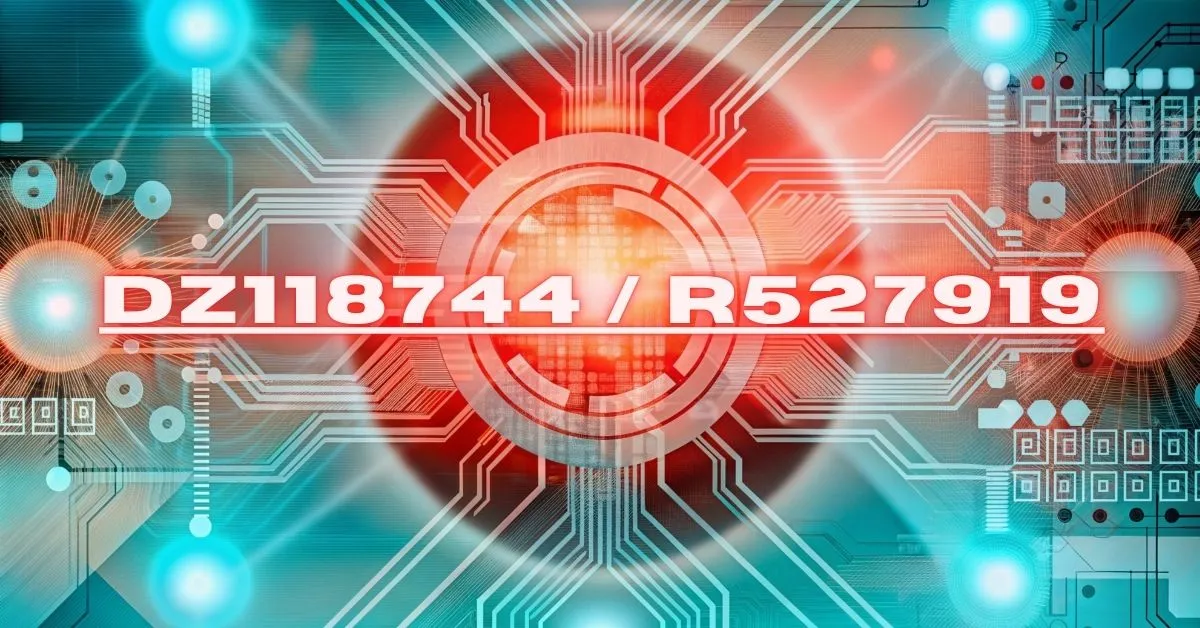In today’s fast-paced landscape of digital innovation, certain identifiers are quietly transforming the very foundation of modern technology. One such standout is dz118744 / r527919—an enigmatic yet powerful code influencing critical sectors. From cutting-edge electronics and next-gen software to precision engineering marvels, this identifier is a silent architect of efficiency and advancement. In this deep-dive, we unravel its significance, explore its applications, and decode the brilliance it brings to innovation-driven industries.
The Origin and Purpose of dz118744 / r527919
At first glance, dz118744 / r527919 might appear to be a standard alphanumeric designation with little to offer. But beneath the surface lies a well-structured code embodying performance, standardization, and technological trust. Developed to facilitate seamless integration across platforms, it acts as a vital classification for advanced systems. Whether it refers to software modules or hardware components, its very presence signals reliability, precision, and next-generation compatibility.
dz118744 / r527919 in Modern Electronics
Boosting Device Capabilities with Smarter Components
In the world of electronics, performance and compact design are non-negotiables—and dz118744 / r527919 delivers on both fronts with finesse. This identifier is often tied to components that optimize power consumption while enhancing data speed and responsiveness. From smartphones to wearables, devices integrated with this code tend to outperform others in efficiency and durability. Users experience not just reliability but also smoother, smarter digital interactions.
Powering Industrial and IoT Infrastructure
Beyond consumer tech, dz118744 / r527919 plays a pivotal role in industrial-grade and IoT-focused systems. It’s commonly linked to robust modules used in sensors, controllers, and automated frameworks that thrive in high-pressure or remote environments. These components are engineered for precision, withstanding harsh conditions while maintaining flawless data relay. As smart cities and connected factories emerge, this code ensures scalable, dependable performance at every level.
Applications of dz118744 / r527919 in Software Development
Optimizing Code Execution and Load Management
Software developers working with high-performance systems are increasingly relying on modules associated with dz118744 / r527919. These are built for speed, memory optimization, and ultra-low latency—ideal for fields like financial modeling, machine learning, and cloud services. With optimized execution paths and cleaner memory handling, such software frameworks dramatically reduce lag. Developers enjoy a boost in productivity, while users benefit from faster, more responsive experiences.
Strengthening Cybersecurity Protocols
As cyber threats evolve, so must our defense mechanisms—and dz118744 / r527919 stands at the forefront of this evolution. This code often marks encryption libraries and authentication modules that have passed rigorous security benchmarks. With features like real-time threat detection, automatic key rotation, and multi-factor validation, it forms a formidable barrier against breaches. Its presence in cybersecurity stacks sends a clear message: safety, trust, and future-readiness.
Engineering Innovations Fueled by dz118744 / r527919
Reinforcing Mechanical Systems
Precision engineering thrives on components that can withstand stress without compromising performance, and dz118744 / r527919 fits that demand perfectly. It is frequently tied to high-spec parts used in aerospace, robotics, and even surgical tools—areas where micro-level precision is life-critical. These components provide both reliability and responsiveness under extreme loads. They help engineers push the boundaries of what’s possible, ensuring every part operates with unerring accuracy.
Advancements in Civil and Structural Engineering
In civil engineering, infrastructure reliability is paramount, and elements bearing dz118744 / r527919 bring that extra edge. They’re often used in load-distributing joints, seismic dampeners, and insulation systems for mega projects. With this identifier, materials are expected to perform under strain, resist corrosion, and maintain structural integrity over decades. As urban centers scale upward and outward, this code ensures every build is smarter, safer, and future-proof.
Benefits of dz118744 / r527919 Across Industries
Standardization and Interoperability
At its core, dz118744 / r527919 represents a universal language of compatibility—a guiding star for seamless integration. Whether you’re designing IoT architecture or embedded systems, this code ensures cross-device communication without glitches. Standardization eliminates the pain of trial-and-error setups, while interoperability reduces integration costs. For engineers and businesses alike, it’s a powerful assurance of streamlined development and consistent performance.
Long-Term Cost Efficiency
While high-performance components can be costlier upfront, those marked with dz118744 / r527919 offer unparalleled value over time. Reduced maintenance, energy savings, and extended lifespans make them financially wise investments. Downtime is minimized, efficiency is maximized, and return on investment becomes more predictable. This makes the identifier especially attractive in sectors where system reliability directly affects the bottom line.
Innovation and Future-Proofing
Future-proofing is no longer optional—it’s a necessity—and dz118744 / r527919 leads the charge in this regard. Its presence indicates readiness for evolving standards, protocols, and applications. Whether scaling a software ecosystem or upgrading industrial machinery, products tied to this code can adapt with minimal disruption. It’s a smart choice for innovators looking to stay relevant, resilient, and ahead of the tech curve.
Real-World Case Studies Featuring dz118744 / r527919
Automotive Electronics
An industry-leading electric vehicle brand upgraded its onboard systems using ECUs labeled dz118744 / r527919, resulting in remarkable enhancements. These control units facilitated faster data interpretation from sensors, leading to quicker decision-making in braking and traction. As a result, vehicle performance improved, energy usage dropped, and driver safety features became more responsive. This case underscores the transformative power of trusted identifiers.
Cloud Computing & Data Centers
A global cloud service provider retrofitted its AI compute infrastructure with hardware accelerators tied to dz118744 / r527919, revolutionizing its operations. The upgrade slashed compute times for deep learning tasks while simultaneously cutting energy consumption. Service reliability and uptime hit new highs, boosting customer satisfaction and operational ROI. This case highlights how backend innovation translates into end-user excellence.
Future Potential of dz118744 / r527919
In Quantum Computing and AI
The dawn of quantum computing and AI demands new standards—and dz118744 / r527919 is poised to be one of them. As quantum processors and AI cores become mainstream, identifiers like this will help regulate compatibility and performance benchmarks. Its adoption will streamline development, prevent redundancy, and unlock true machine intelligence. Expect to see it deeply embedded in the brains of tomorrow’s most intelligent systems.
Global Standardization in a Connected World
As we transition into a fully interconnected era, universal identifiers like dz118744 / r527919 will be crucial. From autonomous transport to cross-border digital infrastructure, global synchronization will hinge on such standard frameworks. This identifier may soon underpin protocols, legal compliance systems, and transnational technology deployments. It’s more than a code—it’s a future cornerstone of global tech harmony.
Contributing to Sustainability and Eco-Tech
Sustainability is now a tech imperative, and dz118744 / r527919 is helping pave the green road ahead. Components and systems tied to this identifier are optimized for energy savings, minimal waste, and longer operational life. These efficiencies significantly reduce environmental footprints in data centers, smart homes, and EVs. By choosing such standards, developers champion not just progress—but responsible, eco-friendly innovation. Conclusion
In conclusion, dz118744 / r527919 isn’t just a sequence—it’s a seal of trust, innovation, and adaptability. It connects engineers, developers, and decision-makers through a unified language of quality and future-readiness. From high-speed computing and aerospace to secure software and green tech, its applications are limitless. As industries scale new frontiers, this humble code may very well be the heartbeat of the next technological renaissance.

